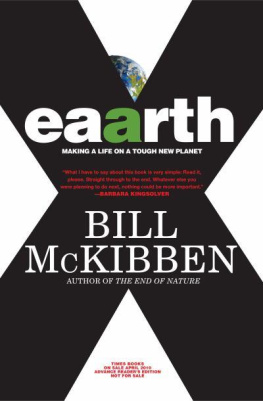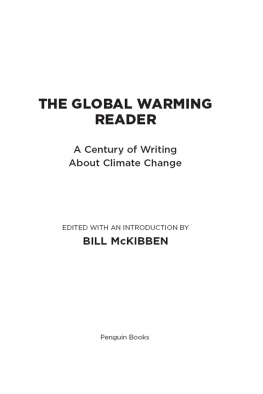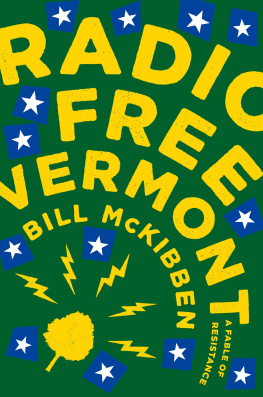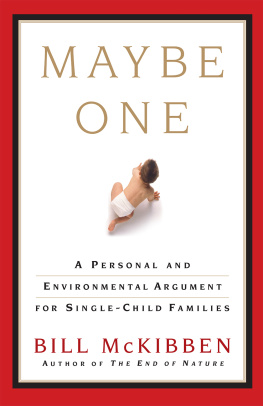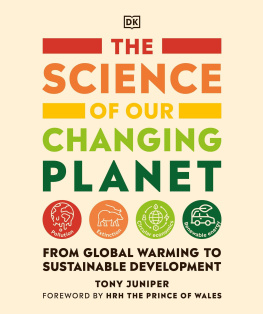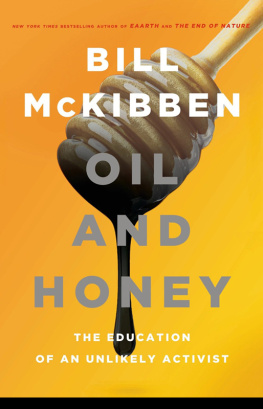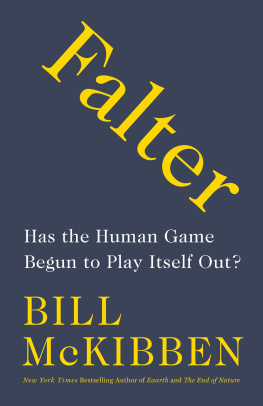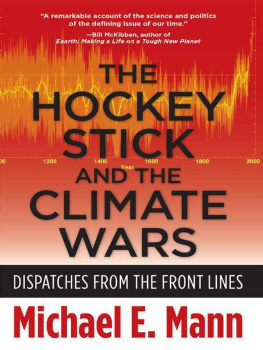ALSO BY BILL MCKIBBEN
The Bill McKibben Reader
Fight Global Warming Now
Deep Economy
Wandering Home
Enough
Long Distance
Hundred Dollar Holiday
Maybe One
The Comforting Whirlwind
Hope, Human and Wild
The Age of Missing Information
The End of Nature
Eaarth

MAKING A LIFE
ON A TOUGH NEW PLANET
BILL McKIBBEN
TIMES BOOKS
HENRY HOLT AND COMPANY NEW YORK

Times Books
Henry Holt and Company, LLC
Publishers since 1866
175 Fifth Avenue
New York, New York 10010
www.henryholt.com
Henry Holt is a registered trademark of
Henry Holt and Company, LLC.
Copyright 2010 by Bill McKibben
All rights reserved.
Library of Congress Cataloging-in-Publication Data
McKibben, Bill.
Eaarth: making a life on a tough new planet / Bill McKibben. 1st ed.
p. cm.
Includes bibliographical references and index.
ISBN 978-0-8050-9056-7
1. Climatic changes. 2. Global warming. 3. Greenhouse effect, Atmospheric. 4. Environmental degradation. 5. NatureEffect of human beings on. I. Title.
QC981.8.C5M3895 2010
304.2dc22
2009030040
Henry Holt books are available for special promotions and
premiums. For details contact: Director, Special Markets.
First Edition 2010
Designed by Kelly S. Too
Printed in the United States of America
1 3 5 7 9 10 8 6 4 2

For Phil Aroneanu, Will Bates, Kelly Blynn, May Boeve,
Jamie Henn, Jeremy Osborn, Jon Warnow, and the thousands
and thousands of people who work with us at 350.org
CONTENTS
Preface
A New World
High Tide
Backing Off
Lightly, Carefully, Gracefully
Notes
Acknowledgments
Index
PREFACE
Im writing these words on a gorgeous spring afternoon, perched on the bank of a brook high along the spine of the Green Mountains, a mile or so from my home in the Vermont mountain town of Ripton. The creek burbles along, the picture of a placid mountain stream, but a few feet away theres a scene of real violencea deep gash through the woods where a flood last summer ripped away many cubic feet of tree and rock and soil and drove it downstream through the center of the village. Before the afternoon was out, the only paved road into town had been demolished by the rushing water, a string of bridges lay in ruins, and the governor was trying to reach the area by helicopter.
Twenty years ago, in 1989, I wrote the first book for a general audience about global warming, which in those days we called the greenhouse effect. That book, The End of Nature, was mainly a philosophical argument. It was too early to see the practical effects of climate change but not too early to feel them; in the most widely excerpted passage of the book, I described walking down a different river, near my then-home sixty miles away, in New Yorks Adirondack Mountains. Merely knowing that wed begun to alter the climate meant that the water flowing in that creek had a different, lesser meaning. Instead of a world where rain had an independent and mysterious existence, the rain had become a subset of human activity, I wrote. The rain bore a brand; it was a steer, not a deer.
Now, that sadness has turned into a sharper-edged fear. Walking along this river today, you dont need to imagine a damned thingthe evidence of destruction is all too obvious. Much more quickly than we would have guessed in the late 1980s, global warming has dramatically altered, among many other things, hydrological cycles. One of the key facts of the twenty-first century turns out to be that warm air holds more water vapor than cold: in arid areas this means increased evaporation and hence drought. And once that water is in the atmosphere, it will come down, which in moist areas like Vermont means increased deluge and flood. Total rainfall across our continent is up 7 percent, and that huge change is accelerating. Worse, more and more of it comes in downpours. Not gentle rain but damaging gully washers: across the planet, flood damage is increasing by 5 percent a year. Data show dramatic increases20 percent or morein the most extreme weather events across the eastern United States, the kind of storms that drop many inches of rain in a single day. Vermont saw three flood emergencies in the 1960s, two in the 1970s, three in the 1980sand ten in the 1990s and ten so far in the first decade of the new century.
In our Vermont town, in the summer of 2008, we had what may have been the two largest rainstorms in our history about six weeks apart. The second and worse storm, on the morning of August 6, dropped at least six inches of rain in three hours up on the steep slopes of the mountains. Those forests are mostly intact, with only light logging to disturb thembut that was far too much water for the woods to absorb. One of my neighbors, Amy Sheldon, is a river researcher, and she was walking through the mountains with me one recent day, imagining the floods on that August morning. You would have seen streams changing violently like that, she said, snapping her fingers. A matter of minutes. A year later the signs persisted: streambeds gouged down to bedrock, culverts obliterated, groves of trees laid to jackstraws.
Our town of barely more than five hundred people has been coping with the damage ever since. We passed a $400,000 bond to pay for our share of the damage to town roads and culverts. (The total cost was in the millions, most of it paid by the state and federal governments.) Now were paying more to line the creek with a seven-hundred-foot-long wall of huge bouldersriprap, its calledwhere it passes through the center of town, a scheme that may save a few houses for a few years, but which will speed up the water and cause even more erosion downstream. Theres a complicated equation for how wide a stream will be, given its grade and geology; Sheldon showed it to me as we reclined on rocks by the riverbank. It mathematically defines streams as we have known them, sets an upper limit to their size. You could use it to plan for the future, so you could know where to build and where to let well enough alone. But none of that planning works if it suddenly rains harder and faster than it has ever rained before, and thats exactly whats now happening. Its raining harder and evaporating faster; seas are rising and ice is melting, melting far more quickly than we once expected. The first point of this book is simple: global warming is no longer a philosophical threat, no longer a future threat, no longer a threat at all . Its our reality. Weve changed the planet, changed it in large and fundamental ways. And these changes are far, far more evident in the toughest parts of the globe, where climate change is already wrecking thousands of lives daily. In July 2009, Oxfam released an epic report, Suffering the Science, which concluded that even if we now adapted the smartest possible curbs on carbon emissions, the prospects are very bleak for hundreds of millions of people, most of them among the worlds poorest.
And so this book will be, by necessity, less philosophical than its predecessor. We need now to understand the world weve created, and considerurgentlyhow to live in it. We cant simply keep stacking boulders against the change thats coming on every front; well need to figure out what parts of our lives and our ideologies we must abandon so that we can protect the core of our societies and civilizations. Theres nothing airy or speculative about this conversation; its got to be uncomfortable, staccato, direct.

